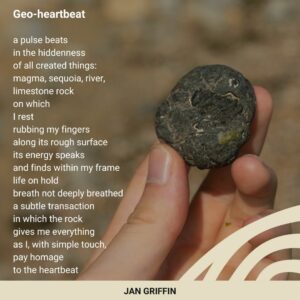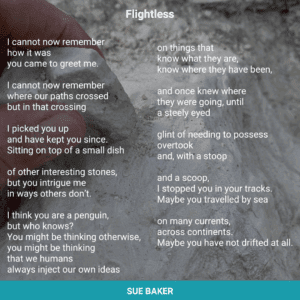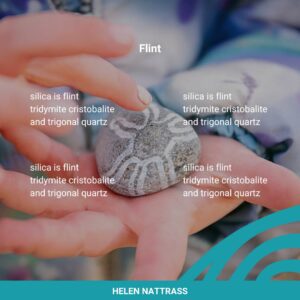Geopoetry and the memory of a stone

July 24, 2025
Geopoetry and the memory of a stone
On November 2nd 2024, a quiet room at The Beaney House of Art and Knowledge in Canterbury felt alive with quiet curiosity as geology turned into poetry and stones began to tell their stories. Geo-Poetry Day, led by Geoambassadors and geologists Helen Nattrass and poet Victoria Field, brought science, art, and personal reflection together in a unique celebration of the earth.
This event was part of the Canterbury Festival’s Umbrella Programme and gave people a chance to connect more deeply with nature.
What is Geopoetry?
Have you ever picked up a pebble and wondered where it came from? Or run your fingers along a flint wall? That simple moment is already a form of geopoetry.
Geopoetry is not just about writing poems about the planet. It’s about sensing the world with all your senses; feeling the coolness of stone, hearing the quiet hum of the earth’s history, and letting your imagination roam through deep time. By weaving together geology, ecology, music, and art, geopoetry helps us feel connected not only to nature but also to ourselves. The Scottish Centre for Geopoetics calls it a way to explore the Earth through many kinds of art and science, helping us all see the planet as one living whole.
Helen and Victoria have been nurturing geopoetry in Canterbury for years, especially through their collaboration on the Wise Words for Wellbeing group. Their shared love for earth science and poetry grew into Wise Words for the Earth, a project offering workshops mixing geological knowledge with writing. Both are passionate Geoambassadors, helping others find connection through this growing movement.
Chalk and flint
In 2024, the Cross-Channel Geopark inspired the workshops with a focus on chalk and flint, two stones that define the local landscape. When many of us feel disconnected from nature, picking up a stone can be a quiet, grounding way to reconnect.
The day was a rich and layered journey through memory, materials, and meaning. You could touch and feel rock samples, study geological maps, and take visual inspiration from the flint sculptures of Henry Moore and the chalk Downs painted by Eric Ravilious.
The sessions were also guided by literary voices. Cornerstones, an anthology edited by Mark Smalley, provided evocative essays like Alyson Hallett’s Chalk, Westbury and Alex Garner’s reflections on flint. These writings opened doors to memory and imagination, revealing the silent strength and hidden stories of stone.
Voices from the day
The day inspired many beautiful poems and stories, showing how alive the earth beneath your feet really is. Everyone who joined gave voice to the silent stories held in stones, capturing not only their physical form but also the deep time and memory they hold.
Jan Griffin’s words in Geo-heartbeat are like the steady pulse of the land, a rhythm linking molten magma, flowing rivers, ancient limestone, and human touch across millions of years. Her words invite you to feel the earth as a living system we all quietly depend on.

Sue Baker’s poems, Flightless and Holding Tight, create intimate conversations between people and stones. They explore time and memory, showing how a small pebble, seemingly ordinary, carries stories of vast journeys and deep connections. Her vivid words ask you to slow down and truly feel the textures of the world around you, reminding you that even the smallest stone can ground your sense of belonging.

Helen Nattrass’s poem Flint traces the remarkable transformation of this mineral, from ancient silica deep within the earth to a sharp-edged tool that helped shape human history. Her words spark the imagination, connecting flint’s physical power with the moment it first sparked fire and survival.

Together, these voices help you understand the landscape better. Stones are more than just lifeless objects. They are witnesses to time, carriers of energy, and partners in our shared story with the earth. Their words invite you to listen closely, touch gently, and reconnect with the world beneath you in new and meaningful ways.
Why Geopoetry matters?
The Cross-Channel Geopark spans from the White Cliffs of Dover and the chalk hills of Kent to the cliffs and plateaus of northern France. Geopoetry is a meaningful way to connect people on both sides of the Channel with the ancient stories written in this land.
At a time when the environment faces many challenges, Geopoetry offers a way to ground ourselves in the earth’s history. It encourages respect, wonder, and care. By blending science with art, it breaks down walls between thinking and feeling, helping us see the planet as a living whole.
Through Geopoetry, you remember you are part of the earth’s story, and that story is worth protecting.
Popular articles
Explore the Cross-Channel Geopark with Our Geotouristic Map
Your guide to the Cross-Channel Geopark: download the free Geotouristic Map and…
GeoAdventures – discover the wonders of the Cross-Channel Global Geopark!
GeoAdventures is a vibrant nine-month festival celebrating the aspiring Cross-Channel UNESCO Global…